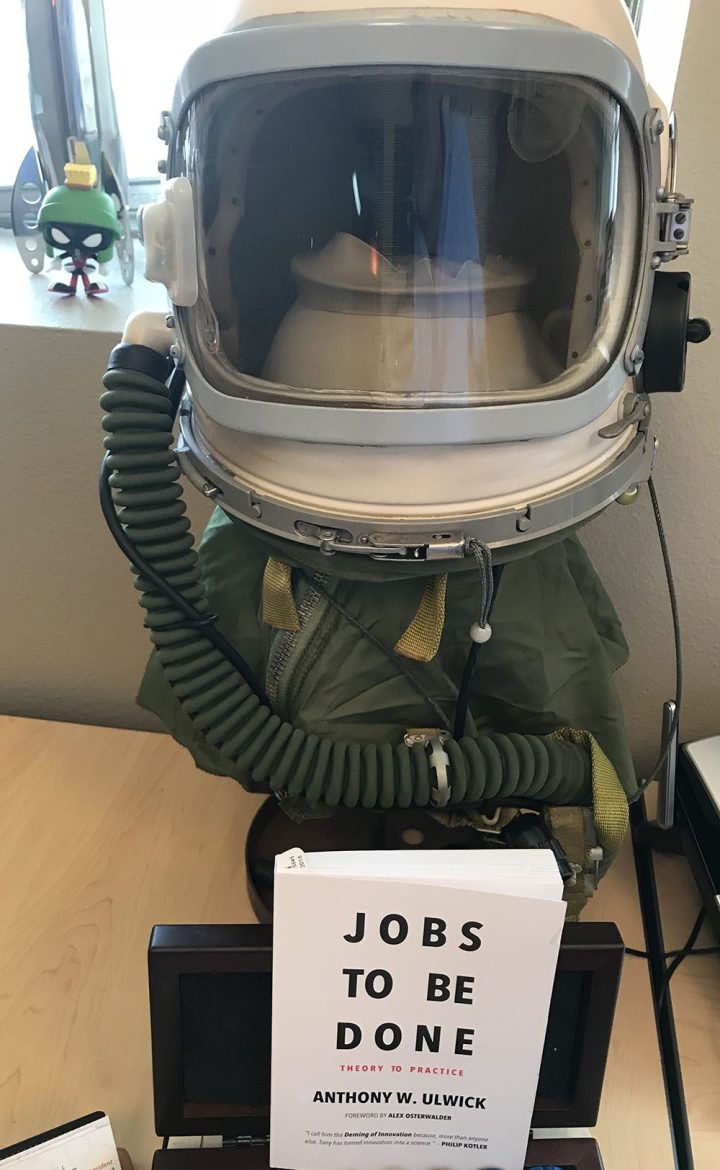
Thumbs Down for the “Jobs to Be Done” Innovation Book by Anthony Ulwick

I recently picked up Anthony Ulwick’s book Jobs to be Done: Theory to Practice looking forward to interesting innovation insights. (This theory is also shortened to JTBD or the hashtag #JTBD.)
But I had barely started the book when I found a claim that research shows the JTBD method has an 86% success rate… based on an oddly tiny number of only 21 projects.
My first surprise is that it looks like the so-called research didn’t look at JTBD as a method but evaluates jobs completed by Ulwick when consulting with companies. Those are VERY different things. A consultant influences a vast number of tiny things in working with a company and we CANNOT jump from “this is what happened with Ulwick consulting” to “on average here’s how JTBD works if a company reads this book and applies it without paying Ulwick.”
And then, there’s the statistics. No one (absolutely no one) should calculate percentages with 21 cases much less make that flakey number the centerpiece of a book on innovation as it is here. This raises concerns for me about Ulwick and his commitment.
Given this, any positive results probably come from things other than JTBD — with personal involvement by Ulwick and his company the primary suspect. Success might also come because Ulwick’s team narrowed client goals by encouraging clients to give up higher risk/higher reward innovation directions.
Truth is that the JTBD approach probably delivers the same 17% success everyone else gets — we just have no way to know.
I read further since this book has become popular. That reading was quite disappointing. Some key thoughts:
Hype is everywhere. Ulwick can’t seem to avoid exaggerating. Even people who embrace JTBD complain to me about the hype. Ulwick tells us his method learns every possible thing about every possible customer in order to leave nothing out. He tells us we have to follow his method to a tee and get our entire company to adopt it. We are told this method does things that weren’t possible “until now” (except I’ve been doing these things for 40 years). He even claims JTBD theory “unlocks the mystery” of innovation – I guess making it as easy as filling out your taxes. This book is raises concerns about Ulwick’s participation in a consultant culture which under-delivers at high cost.
Ulwick’s closed-ended approach is bad methodology. I’ve spent 40 years (so far) with innovation. No process is complete. We must work in ways that allow for, and even seek, surprises. We need to leave open doors so that good things come through them. And we must be prepared to re-work innovations based on what we discover. We must know that our customers, being human, are so complex that no methodology can accurately discover or summarize everything important about them. (You might find this post from my blog interesting.)
Then I am told: “But Ulwick is just saying to listen to customers and that’s good.” Listening to customers IS good – when you listen with an open mind. But JTBD theory handcuffs “listen to customers” with lists of items to be categorized, filled in, compiled, tabulated, percentagized, etc….. We are told to make lists, compile matrices, etc, etc. Busy-work like this gets in the way of listening. You’ll learn more when you shut the laptop and listen!!!
Ulwick’s research recommendations are ill considered. On page 87 there is a discussion of the kinds of questions for research.
-
- Ulwick says “It’s incorrect to ask ‘what job did you hire that product to do’?” Absolutely right. That’s a terrible question.
- Ulwick recommends instead that we “Ask ‘Why are you using that product, what job are you ultimately trying to get done’?” Wow. That’s an absolutely terrible question, as well. Instead, good research starts with something like “tell me about using the product” to begin a long and in-depth discussion. That conversation (not questioning) will reveal what was going on at time of purchase as well as what is satisfying in owning/using the product. Purchase is often moved by different things than satisfaction with ownership.
- What I see in these comments is a process designed for engineering. Yet truly great innovation research MUST be customer centric — not engineering centric. Lacking thorough marketing knowledge (Ulwick is an engineer, Christensen who influenced him heavily is an economist), I simply want to recommend they go take Consumer Behavior 101 then think about what they’ve written. What you need to comprehend is how your product fits into the customer’s life/work — with “fit” including all kinds of things from tasks, needs, and obligations to emotions, hopes and dreams, and all the other things they use it alongside.
- Wide open research is needed for innovation – NOT ULWICK’S CLOSED ENDED recommendations. I am incredulous that he claims lots of experience yet makes comments like above. Perhaps he’s too influenced by corporately bureaucratic researchers.
“But there are case studies.” I know quite thoroughly the category for one of the primary heroic case studies having spent 30 years marketing hardware and tool innovations including circular saws. Let’s look at his Bosch case study.
- Ulwick claims: “There had not been much innovation in the circular saw market. …It was perceived as mature and commodity-like.” The Truth: Not much innovation? By who? Bosch certainly hadn’t done much. And it sounds like Ulwick assumes there hadn’t been much. But that ignores companies like Festool (followed by DeWalt and Triton) who created the track saw – a much more important advance on the circular saw. The track saw is far more interesting than anything Ulwick suggests. Kreg Tool has recently started selling circular saw customers an exceptional set of accessories for ripping and cutting sheet goods to support building with their pocket hole & screw products. Bosch? Yawn.
- Ulwick claims: There was a “hidden segment” of “finish and advanced carpenters”. The Truth: These weren’t hidden (Wikipedia tells me this union was formed in 1881). My hunch is they may have been hidden to Bosch and Ulwick through weak marketing (of course, he isn’t a marketer). The comment says more about Ulwick than the market. Festool, DeWalt, Triton, and Kreg ALL target finish and advanced carpenters.
- Ulwick Claims: Bosch made innovative changes – like directly connecting the extension cord to the saw and making it easier to see the blade working on the cut line. The Truth: My cheap Black & Decker hedge trimmer had that cord connection already in 1995 and the changes for visibility are nice, but not game changing. Go check out the Festool track saw.
Ulwick seems to claim success because Bosch wasn’t in the US market before this work. That means the response to the product was primarily because a circular saw from Bosch was new to the US market. Thus, it hadn’t been on the shelves but, because it was Bosch, they obtained superb physical distribution very quickly. What impact did the incremental innovations have? Probably not much compared with the new distribution and latent demand.The nature of the changes speak poorly for JTBD and make me concerned that it’s a small ball methodology.
All-in-all, I come away from the book mystified by the popularity of Jobs to be Done.
Ulwick’s book may hurt innovation. I’ve been reading lately about the difference between “complex” and “complicated” problems as describe by Rick Nason in his recent book It’s Not Complicated. Nason developed the book based on reading the scientific work on complexity and looked to apply the theory in business.
Nason points out that business tends to decide all problems are complicated – the types of problems that can be reduced into smaller problems and solved by conquering each smaller problem. By contrast, Nason points out that complex problems, when solved appropriately, create the biggest strategic advantage for companies. Yet to make progress with complex problems, you cannot use the reduction approach.
Innovation is, by it’s nature, a complex problem (that’s what’s tremendously exciting about it). Yet Ulwick offers us a classic complicated solution to a complex problem. Nason points out that trying to use reductionist approaches with complex, more holistic, problems will always be wrong. In other words, the underwhelming result of the Bosch case study result is to be expected.
My conclusions on Ulwick’s approach to Jobs to be Done
Many individuals have found inspiration in Ulwick’s JTBD and it’s good that people find individual inspiration they can use to build their individual visions.
Still, we should be concerned that this book’s popularity will broadly hurt innovation. (Executives are already concerned about low returns from innovation spending.) Ulwick’s Jobs to be Done theory is a small-ball approach — so conservative and cautious that it won’t create a foundation for the kind of innovations Clayton Christensen features in his books.
Certainly it’s a good thing to listen to customers and Ulwick has a couple of decent structures for thinking about customers. But the good is rare in this book. Worse, the hype suggests he’s discovered something new. In reality, this is a very, very basic book — not a process for conquering innovation.
The word “Job” is also a poor choice because it limits the imagination. Innovators must discover things people will want – things they value enough to pay for them. There’s a fascinating spectator sport listening to the mental gymnastics of JTBD enthusiasts trying explain everything as “a job”.
 Let me recommend a few stimulating or provocative books which help us comprehend the complexity of innovation. Organizing Genius by Warren Bennis, et. al., The Halo Effect by Phil Rosenzweig, and The Creative Habit by Twyla Tharp. And as a cautionary read, Chronicle of a Death Foretold by Gabriel Garcia Marquez (it’s a short, readable novel).
Let me recommend a few stimulating or provocative books which help us comprehend the complexity of innovation. Organizing Genius by Warren Bennis, et. al., The Halo Effect by Phil Rosenzweig, and The Creative Habit by Twyla Tharp. And as a cautionary read, Chronicle of a Death Foretold by Gabriel Garcia Marquez (it’s a short, readable novel).
Closing Thoughts
My background isn’t all that different from Ulwick’s — including extensive experience in tech — except I’ve spent 30 years introducing new products to the market from a marketer’s point of view. As a result, I’ve seen plenty of failures and some excellent successes. This book seems to reflect an engineer who discovered a few things about people then tried to turn that limited view into a broad theory. In that, it is a failure.
True innovators cannot claim mastery unless they know 100 different approaches and, after considering the situation in front of them, choose the 4-5 that may be useful today. The same is true for market research approaches leading toinnovation discovery. There are 100’s of approaches and those who master innovation choose the ones that fit their specific challenge.
Ulwick’s popularity comes by promising what cannot be promised — a neat and tidy solution designed to appeal to executives. In making executives happy, he ensures they’ll get a low returns on their investment into innovation.
So read the book if you’d like. Then forget most of what it says in order to focus on what’s truly important: the incredibly complex challenge of innovation.
© 2018, 2022 – Doug Garnett – All Rights Reserved
Categories: Business and Strategy, Innovation

Posted: June 4, 2018 14:15
Alan Klement
Posted: June 5, 2018 00:56
Doug Garnett